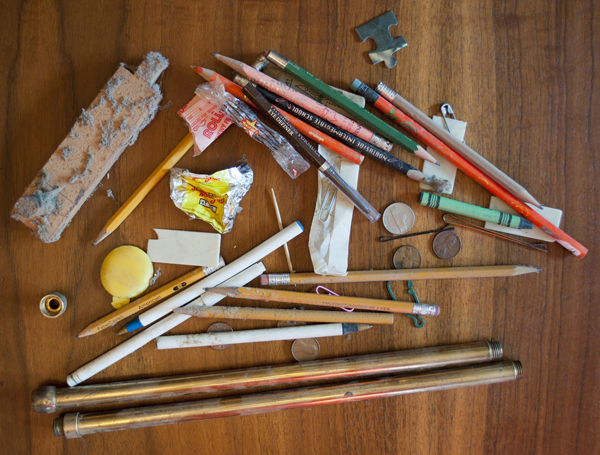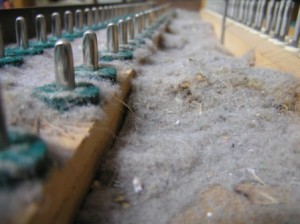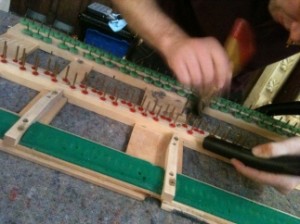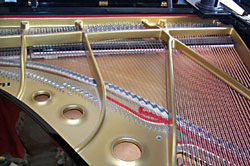So, what does lurk inside your piano?
Have you ever even seen the inside of your piano?
I was thinking a lot about this yesterday as I was designing a new page for my website: www.RichardsPianoService.com/cleaning.html. I’ve come to the conclusion, through many years of servicing pianos, that most customers that I see for the first time have never even seen the inside of their piano, especially owners of uprights. That is somewhat surprising to me since, at the very least, the lids on uprights need to be raised and the front music desk needs to be removed just in order to tune the piano. Beyond that, the key cover is often removed and keys sometimes removed for key repair, key adjustments, or to remove that coin that is jammed between two keys, causing them not to function. On top of that, the bottom knee board is usually removed to inspect the bridge and make any pedal adjustments, and the entire action has to be removed in both uprights and grands in order to service any of the mechanical parts of the piano that have been broken or need adjustment. While much of that is all in a days work for me, many tuners never make those simple repairs or adjustments, never pull the action, or never clean anything, so all the customer ever sees is the tuning pin area…which on uprights, usually doesn’t collect much dust. That tells me that those customers who act so surprised that their piano comes all apart like it does during regular servicing have either never had their piano tuned, OR, IF their tuner did more than a bare minimum tuning, the customer wasn’t there to see it. It also tells me that there are a good MANY pianos out there that could stand a good cleaning!
On a grand, only the lid needs to be raised in order to tune the piano, and much of the time, the piano has been left open, so the customer is used to seeing the pinblock, dampers, and strings on their piano. However, the insides of the piano look somewhat mysterious and fragile, so most grand owners leave the inside pinblock, damper, and string area alone…not knowing what to do.
While keeping your piano closed up all the time will help considerably, a piano will still collect a lot of dust and dirt over time and it will eventually need to be cleaned out to free up the working mechanisms of the piano. The fact remains that a vast majority of pianos have not been kept closed up all the time and have been collecting dirt for ages. Many old uprights have never been cleaned in their 80 to 100 years, and it shows when I go to service them! Grands are often left with their lids up for looks, and dust and dirt will quickly collect on all the horizontal surfaces.
So, what does lurk inside your piano? Every piano gradually collects years of dust and grit inside the piano in places where the piano owner rarely, if ever, will see. The dust and grit eventually works its way down into all the little nooks and crannies of the piano where all the working mechanisms of the piano are, and it can lead to premature wear and eventually to serious, and costly, mechanical problems.

Typical Junk Found in and around Piano Keys
It is really common to find paper clips, coins, can pull tabs, stamps, stickers, bobby pins, straight pins, rubber bands, pencils, and other foreign objects under the keys and amidst the action’s working parts, especially in homes where there are small children…or if the piano once resided in a home with small children. Very often the key lid can act just like a postage drop box, depositing pencils into the action area when the key lid is opened. A single pencil can cause 5 or 6 keys to jam if it gets lodged in the wrong places. When the jammed key is pressed, small wooden parts inside can break. Mouse nests and their droppings can jam up the action and cause trouble. Debris in a piano can sometimes lead to hundreds of dollars in repairs down the road if not removed before permanent damage is done.

Years of dust build up under Key Bed.
Technicians (that I happen to know personally) have found dead birds, mice (see important note below about Hantavirus), envelopes of cash, and “hidden” whiskey bottles from husbands who swore they quit drinking years ago! I found a home-made dehumidifier once….basically a 100 watt light bulb on a frayed cord, waiting to burn the house down if plugged in. I found a mouse nest measuring over 15″ in diameter and 3-4″ tall on top of the key sticks in an old upright, and all sorts of other things that don’t belong in pianos.
Your piano will only work as freely as it was designed to if it is clean and free of such debris.

Grand Key Bed being cleaned
Because of all the fragile parts in a piano, it is not recommended for the piano owner to attempt to clean the inside of their piano. Water and chemicals, etc. can be corrosive to the fragile metal parts of the piano. Sprays containing oils can cause pin block damage which will lead to slipping tuning pins. Even dusting and vacuuming can cause serious problems if any of the thousands of fragile parts are bumped, snagged, mishandled, broken, misplaced, or accidentally sucked up in the vacuum cleaner. Cleaning the piano’s interior is best left to the professional piano technician.
I will, however, offer a few things that you can do yourself to help keep your piano clean, and I’ll also suggest things you should leave to guys like me who have the proper training to deal with the more fragile parts of your piano.
Here are some things you can do yourself (at your own risk, of course):
All piano owners: First of all, you can keep your piano covered or closed up as much as possible, and vacuum your home on a regular basis, especially if you have shedding pets. Don’t get in the habit of setting small objects on the piano (paper clips, loose change, etc), and don’t allow children to play on or around the piano with small toys.
Refer to the Piano Technician’s Guild’s webpage for recommendations for dusting and cleaning your piano’s exterior case. In summary: dust with a feather duster, then slightly damp rag (flannel or microfiber cloth). DO NOT wipe in circles, but in direction of the grain or direction the finish was applied. make sure any water residue is light enough to quickly evaporate. Avoid most sprays and polishes, as they can contain oils that can damage the strings and pin block.
Upright owners: Most of the time it is perfectly alright for you to lift the top lid, and remove the front music desk board. There are usually either a couple screws on either side that hold the board to the piano, or some sliding or rotating wooden latches. Once the lid is up and front board off, you may vacuum (see important note below about Hantavirus) anywhere along the tops of the keys and off to the sides of the keys at either end of the piano. Be SUPER CAREFUL not to touch or snag any part of the action. If there is dust on the felt hammers, you may carefully vacuum the tops of the hammers, but in a front to back motion. If you snag a hammer side to side, it can wreck the fragile hinge parts inside the action. I would stay away from the dampers since they are very fragile and a vacuum can do harm to them! You may also vacuum the tuning pin area, and or use a toothbrush to get any tough places if you wish. Next, you may remove the bottom knee board by pressing up on the spring retainer clip(s) and pulling the top of the board out first. Lift the board off the pegs that hold it in place at the bottom and set aside. You may vacuum the entire area around the pedal rods and levers. Not much you can hurt down here, unless you have a humidity control system installed. Replace the knee board when finished and close up the rest of the piano. You may clean the key tops with a damp (not wet) rag with some mild dish soap. For the exterior case, refer to the Piano Technician’s Guild website for recommendations.
Grand owners, It is perfectly fine, and recommended, to vacuum the pin block area and use a toothbrush, pipe cleaner, etc. to loosen dirt in hard to reach areas around the pins and strings. Just be gentle as to not pry against the strings, causing them to shift position. That can altar your tuning. Use no water or sprays around the tuning pins! If you need a bit of moisture to help remove the grime, very lightly dampen the tip of a rag, but keep the water source away from the piano! You don’t want a cup of water tipped over on your pin block!

Grand Piano plate and soundboard
You may vacuum (see important note below about Hantavirus) anything you can see, being careful around the dampers and being careful not to scratch the plate or soundboard with the vacuum nozzle. If you want, you may purchase a set of felt soundboard cleaners that will help you reach under the strings to clean the soundboard in places the vacuum won’t reach. Some have used a cloth and yard stick or something flexible to reach under the strings. Again, for the exterior case, refer to the Piano Technician’s Guild webpage for recommendations.
IMPORTANT NOTE about Hantavirus: Mice fecal material can carry Hantavirus, which can be extremely dangerous. Be sure to use proper mask, latex gloves, etc. while removing mouse/rat infestations. Scoop and dump the majority of it very carefully so as not to get the contaminants airborne. Then use a vacuum (with hepa-filter if possible) to clean up the remainder. Click here to find out more information on Hantavirus.
If your piano hasn’t been cleaned in several years (or ever, in many cases) it could greatly benefit by having a complete cleaning. Almost inevitably, you will notice a difference in how your piano plays and sounds just by having it thoroughly cleaned…and hey, any money found in the piano is yours! : ) Usually that amounts to only a few cents…but you never know!
Until next time…Make a Joyful Noise!